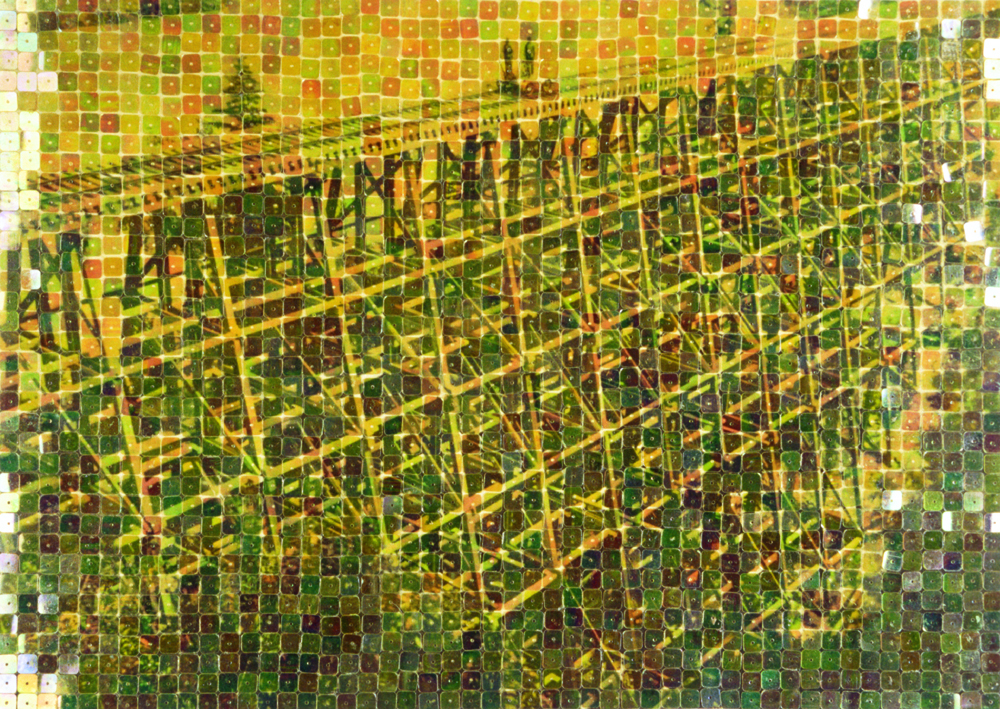The Last Spike
Andrew Harwood
February 7 - March 8, 2003

Last Spike is the third exhibition in my Canadiana Trilogy Series. Previous bodies of work have explored sites and events important to Canadian history. I deal with this subject manner with a sense of humour, glamour and through camp expressions (i.e. glitter, shaky eyes, glue guns, rubber, colour photocopy - etc.). Expo '67 in Montreal was the subject matter for Expo and The 88 Suite played with the Calgary Winter Olympics.
C.N. removed the railroad tracks from my hometown, Wiarton, Ontario in the late seventies. Around the same time Pierre Berton's The National Dream was written and later turned into a CBC documentary (the last episode was called The Last Spike). This era proved to be the finale for many rural Ontario industries. Tourism replaced the small manufacturing and food processing industries that surrounded the long-standing agricultural base of the region. Trains were no longer necessary as cattle and other goods were moved more cheaply and efficiently with transport trucks (which spawned a plethora of trucker films with sexy hunky male stars but that's another show!)
When the C.N. deconstruction crews came to town to remove the tracks it was a sad day for everyone as we all realised it was the end of an era. It also meant that Wiarton was no longer the end of the line. This was a place where folks with unusual problems or on the run from them or Americans ended up, because it was quite literally "the end of the line". The C.N.'s departure and ultimate dismantling of the railroad left us townspeople with an elevated black ridge crossing through the town like a huge scar, a large pile of creosote rail ties and thousands of cast irons spikes. My collection of these iron objects will be the basis for the sculpture works entitled Spikes. These spikes will be cast in rubber in many colours and placed on the floor on top of another work made of back-lit white Plexiglas, called Absent Track. This work will portray the missing track by showing the ties and rails in a negative relief pattern and be lit from below with flourescent lights.
During this same period of time in the seventies, a famous bar emerged on the gay S.M. scene in New York City called The SPIKE (which I discovered in a documentary on television). It was a place where gay men went to fulfil their fantasies often in very public ways on the dance floor, in dark corners and on stage. I was forbidden to watch the movie Cruising, but our family all watched The SPIKE documentary together on T.V., I came to discover that these two seemingly unrelated things, the railroad and the acceptance of gays in the media and generally, coincided with my own emergence as an adult or coming of age (I hate that expression, but it does kind of fit this quasi-narrative) and the recognition of my own desires. Little did I know that this gay fantasy world at The SPIKE in NYC would also come to an abrupt end with the onslaught of AIDS in the eighties and become an obsolete site of pleasure and a parallel to the train's demise where I grew up.
I will be producing a series of photographic images called Sequined History, which represent the terrain and regions that the railroad was built upon. Sequins will be superimposed overtop of the historical images to create a new and, if you will, gay vision of Canadian history (not a revisionist history because I hate how some movements reclaim and quite possibly fake historical facts). Historical images in drag.
The reason for this project is simple in that it completely frustrates me how Canadians generally view our own history as being boring. And yes, some of it is -- but look at how sexy the Americans make the first Thanksgiving look on T.V. and in the media. I want to add a dash of glamour and camp to the unusual industrial and imperial origins of our country. Even the Aussies with all of their bloody sheep glamourize and popularize their own history better than we do! As a result of this frustration and with my tongue firmly in cheek I will also be producing a series of portraits of Pierre Berton to honour his sincere desire and success in making history exciting and accessible to Canadians.
Last Spike is meant to merge several sets of ideals based on broad, popular and historical notions of Canadian identity using the railroad, post - identity aesthetics, seventies gay sub-culture and my particular memories of small town Ontario.
- Andrew Harwood
